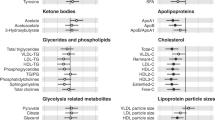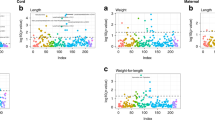Abstract
Arsenic exposure has been associated with low birth weight. However, the underlying mechanisms are not well understood. Alterations to metabolites may act as causal mediators of the effect of arsenic exposure on low birth weight. This pilot study aimed to explore the role of metabolites in mediating the association of arsenic exposure on infant birth weight. Study samples were selected from a well-established prospectively enrolled cohort in Bangladesh comprising 35 newborns and a subset of 20 matched mothers. Metabolomics profiling was performed on 35 cord blood samples and 20 maternal peripheral blood samples collected during the second trimester of pregnancy. Inorganic arsenic (iAs) exposure was evaluated via cord blood samples and maternal toenail samples collected during the first trimester. Multiple linear regression and mediation analyses were used to explore the relationship between iAs exposure, metabolite alterations, and low birth weight. Cord blood arsenic level was correlated with elevated levels of 17-methylstearate, laurate (12:0) and 4-vinylphenol sulfate along with lower birth weight. Prenatal maternal toenail iAs level was associated with two peripheral blood metabolites (butyrylqlycine and tartarate), which likely contributed to higher cord blood iAs levels both independently and interactively. Findings of this pilot study indicate that both intrauterine and maternal peripheral blood metabolites appear to influence the toxic effect of inorganic arsenic exposure on low birth weight.
This is a preview of subscription content, access via your institution
Access options
Subscribe to this journal
Receive 6 print issues and online access
$259.00 per year
only $43.17 per issue
Buy this article
- Purchase on Springer Link
- Instant access to full article PDF
Prices may be subject to local taxes which are calculated during checkout



Similar content being viewed by others
References
Garcia-Sevillano MA, Contreras-Acuna M, Garcia-Barrera T, Navarro F, Gomez-Ariza JL . Metabolomic study in plasma, liver and kidney of mice exposed to inorganic arsenic based on mass spectrometry. Anal Bioanal Chem 2014; 406: 1455–1469.
Kile ML, Baccarelli A, Hoffman E, Tarantini L, Quamruzzaman Q, Rahman M et al. Prenatal arsenic exposure and DNA methylation in maternal and umbilical cord blood leukocytes. Environ Health Persp 2012; 120: 1061–1066.
Ding W, Hudson LG, Liu KJ . Inorganic arsenic compounds cause oxidative damage to DNA and protein by inducing ROS and RNS generation in human keratinocytes. Mol Cell Biochem 2005; 279: 105–112.
Sepand MR, Razavi-Azarkhiavi K, Omidi A, Zirak MR, Sabzevari S, Kazemi AR et al. Effect of acetyl-L-carnitine on antioxidant status, lipid peroxidation, and oxidative damage of arsenic in rat. Biol Trace Elem Res 2015; 171: 107–115.
Shen J, Wanibuchi H, Waalkes MP, Salim EI, Kinoshita A, Yoshida K et al. A comparative study of the sub-chronic toxic effects of three organic arsenical compounds on the urothelium in F344 rats; gender-based differences in response. Toxicol Appl Pharmacol 2006; 210: 171–180.
Kitchin KT . Recent advances in arsenic carcinogenesis: modes of action, animal model systems, and methylated arsenic metabolites. Toxicol Appl Pharmacol 2001; 172: 249–261.
Rossman TG . Mechanism of arsenic carcinogenesis: an integrated approach. Mutat Res 2003; 533: 37–65.
Laine JE, Bailey KA, Rubio-Andrade M, Olshan AF, Smeester L, Drobna Z et al. Maternal arsenic exposure, arsenic methylation efficiency, and birth outcomes in the Biomarkers of Exposure to ARsenic (BEAR) pregnancy cohort in Mexico. Environ Health Perspect 2015; 123: 186–192.
Pan WC, Seow WJ, Kile ML, Hoffman EB, Quamruzzaman Q, Rahman M et al. Association of low to moderate levels of arsenic exposure with risk of type 2 diabetes in Bangladesh. Am J Epidemiol 2013; 178: 1563–1570.
Tsai SY, Chou HY, The HW, Chen CM, Chen CJ . The effects of chronic arsenic exposure from drinking water on the neurobehavioral development in adolescence. Neurotoxicology 2003; 24: 747–753.
Kile ML, Cardenas A, Rodrigues E, Mazumdar M, Dobson C, Golam M et al. Estimating effects of arsenic exposure during pregnancy on perinatal outcomes in a Bangladeshi cohort. Epidemiology 2016; 27: 173–181.
Hosain GM, Chatterjee N, Begum A, Saha SC . Factors associated with low birthweight in rural Bangladesh. J Trop Pediatr 2006; 52: 87–91.
Cifuentes J, Bronstein J, Phibbs CS, Phibbs RH, Schmitt SK, Carlo WA . Mortality in low birth weight infants according to level of neonatal care at hospital of birth. Pediatrics 2002; 109: 745–751.
Simeoni U, Boubred F, Buffat C, Grandvuillemin I, Ligi I . [Risk for long term disease in low birth weight infants]. Arch Pediatr 2010; 17: 669–670.
Ivorra C, Garcia-Vicent C, Chaves FJ, Monleon D, Morales JM, Lurbe E . Metabolomic profiling in blood from umbilical cords of low birth weight newborns. J Transl Med 2012; 10: 142.
Ciborowski M, Zbucka-Kretowska M, Bomba-Opon D, Wielgos M, Brawura-Biskupski-Samaha R, Pierzynski P et al. Potential first trimester metabolomic biomarkers of abnormal birth weight in healthy pregnancies. Prenat Diagn 2014; 34: 870–877.
Zhang J, Shen H, Xu W, Xia Y, Barr DB, Mu X et al. Urinary metabolomics revealed arsenic internal dose-related metabolic alterations: a proof-of-concept study in a Chinese male cohort. Environ Sci Technol 2014; 48: 12265–12274.
Wei Y, Wang Z, Su L, Chen F, Tejera P, Bajwa EK et al. Platelet count mediates the contribution of a genetic variant in LRRC16A to ARDS risk. Chest 2015; 147: 607–617.
Saha KK, Engstrom A, Hamadani JD, Tofail F, Rasmussen KM, Vahter M . Pre- and postnatal arsenic exposure and body size to 2 years of age: a cohort study in rural Bangladesh. Environ Health Persp 2012; 120: 1208–1214.
Rodrigues EG, Kile M, Dobson C, Amarasiriwardena C, Quamruzzaman Q, Rahman M et al. Maternal-infant biomarkers of prenatal exposure to arsenic and manganese. J Expo Sci Environ Epidemiol 2015; 25: 639–648.
Huyck KL, Kile ML, Mahiuddin G, Quamruzzaman Q, Rahman M, Breton CV et al. Maternal arsenic exposure associated with low birth weight in Bangladesh. J Occup Environ Med 2007; 49: 1097–1104.
Rodriguez-Barranco M, Lacasana M, Aguilar-Garduno C, Alguacil J, Gil F, Gonzalez-Alzaga B et al. Association of arsenic, cadmium and manganese exposure with neurodevelopment and behavioural disorders in children: a systematic review and meta-analysis. Sci Total Environ 2013; 454-455: 562–577.
Chen KL, Amarasiriwardena CJ, Christiani DC . Determination of total arsenic concentrations in nails by inductively coupled plasma mass spectrometry. Biol Trace Elem Res 1999; 67: 109–125.
Cheikh Ismail L, Knight HE, Bhutta Z, Chumlea WC . International F, Newborn Growth Consortium for the 21st C. Anthropometric protocols for the construction of new international fetal and newborn growth standards: the INTERGROWTH-21st Project. BJOG 2013; 120: 42–47, v.
Bohnke JR . Explanation in causal inference: methods for mediation and interaction. Q J Exp Psychol 2016; 69: 1243–1244.
Valeri L, VanderWeele TJ . SAS macro for causal mediation analysis with survival data. Epidemiology 2015; 26: e23–e24.
Kile ML, Rodrigues EG, Mazumdar M, Dobson CB, Diao N, Golam M et al. A prospective cohort study of the association between drinking water arsenic exposure and self-reported maternal health symptoms during pregnancy in Bangladesh. Environ Health 2014; 13: 29.
Wang XX, Mu XL, Zhang J, Huang QY, Alamdar AV, Tian MP et al. Serum metabolomics reveals that arsenic exposure disrupted lipid and amino acid metabolism in rats: a step forward in understanding chronic arsenic toxicity. Metallomics 2015; 7: 544–552.
Kim YJ, Hong YC, Lee KH, Park HJ, Park EA, Moon HS et al. Oxidative stress in pregnant women and birth weight reduction. Reprod Toxicol 2005; 19: 487–492.
James AM, Collins Y, Logan A, Murphy MP . Mitochondrial oxidative stress and the metabolic syndrome. Trends Endocrinol Metab 2012; 23: 429–434.
Li C, Li P, Tan YM, Lam SH, Chan EC, Gong Z . Metabolomic characterizations of liver injury caused by acute arsenic toxicity in zebrafish. PLoS One 2016; 11: e0151225.
Carreras-Badosa G, Prats-Puig A, Puig T, Vazquez-Ruiz M, Bruel M, Mendoza E et al. Circulating fatty acid synthase in pregnant women: relationship to blood pressure, maternal metabolism and newborn parameters. Sci Rep 2016; 6: 24167.
Alberts AW, Strauss AW, Hennessy S, Vagelos PR . Regulation of synthesis of hepatic fatty acid synthetase: binding of fatty acid synthetase antibodies to polysomes. Proc Natl Acad Sci USA 1975; 72: 3956–3960.
Sleboda J, Bremer J, Horn RS . Palmitate oxidation in rat hepatocytes is inhibited by foetal calf serum. Acta Physiol Scand 2001; 173: 267–274.
Sasaki Y, Kozaki A, Hatano M . Link between light and fatty acid synthesis: thioredoxin-linked reductive activation of plastidic acetyl-CoA carboxylase. Proc Natl Acad Sci USA 1997; 94: 11096–11101.
Rogers I, Emmett P, Ness A, Golding J . Maternal fish intake in late pregnancy and the frequency of low birth weight and intrauterine growth retardation in a cohort of British infants. J Epidemiol Community Health 2004; 58: 486–492.
Isganaitis E, Rifas-Shiman SL, Oken E, Dreyfuss JM, Gall W, Gillman MW et al. Associations of cord blood metabolites with early childhood obesity risk. Int J Obes 2015; 39: 1041–1048.
Petersen AK, Zeilinger S, Kastenmuller G, Romisch-Margl W, Brugger M, Peters A et al. Epigenetics meets metabolomics: an epigenome-wide association study with blood serum metabolic traits. Hum Mol Genet 2014; 23: 534–545.
Acknowledgements
We would like to acknowledge Nicola Lupoli, Ivan Pantic, Shangzhi Gao, Jongeun Rhee, Pi-I (Debby) Lin, Sakila (Joya) Afroz and Hafiza (Suchanda) Sultana for laboratory support. This study was supported by the National Institute of Environmental Health Sciences (NIEHS) (P30ES000002 and ES0015533 to DCC); the National Natural Science Foundation of China (81402764 to YW, 81402763 to RZ, 81473070 and 81530088 to FC); and the Natural Science Foundation of Jiangsu, China (No. BK20140907 to YW). The work was also partially supported by a project funded by the Priority Academic Program Development of Jiangsu Higher Education Institutions (PAPD) and the Outstanding Young Teachers Training Program of Nanjing Medical University.
Author contributions
YW, FC and DCC were responsible for the study’s conception; YW and QS performed the study design, data analyses and wrote the manuscript; QQ, MR, ZW and LS collected the samples, processed the samples for analysis and performed the arsenic level evaluation; RZ contributed to the discussion and revised the manuscript. All authors approved the final version of the manuscript.
Author information
Authors and Affiliations
Corresponding authors
Ethics declarations
Competing interests
The authors declare no conflict of interest.
Additional information
Supplementary Information accompanies the paper on the Journal of Exposure Science and Environmental Epidemiology website
Supplementary information
Rights and permissions
About this article
Cite this article
Wei, Y., Shi, Q., Wang, Z. et al. Maternal/fetal metabolomes appear to mediate the impact of arsenic exposure on birth weight: A pilot study. J Expo Sci Environ Epidemiol 27, 313–319 (2017). https://doi.org/10.1038/jes.2016.74
Received:
Revised:
Accepted:
Published:
Issue Date:
DOI: https://doi.org/10.1038/jes.2016.74
Keywords
This article is cited by
-
A feasibility study of metabolic phenotyping of dried blood spot specimens in rural Chinese women exposed to household air pollution
Journal of Exposure Science & Environmental Epidemiology (2021)
-
Transplacental exposure to carcinogens and risks to children: evidence from biomarker studies and the utility of omic profiling
Archives of Toxicology (2019)
-
Integrating -Omics Approaches into Human Population-Based Studies of Prenatal and Early-Life Exposures
Current Environmental Health Reports (2018)



